The two Magellanic Clouds visible from the southern hemisphere are irregular dwarf galaxies caught in a slow gravitational dance with the Milky Way. Their brilliant light travelling the distance of about 200 000 light-years to reach the Earth makes them one of the most dazzling objects in the night sky.
Key Facts & Summary
- The two Magellanic Clouds is a binary galactic system transiting our neighbourhood at a distance between 160 and 200 hundred light-years.
- It is comprised of two irregular dwarf galaxies known as the Large and Small Magellanic Clouds, abbreviated as LMC and SMC.
- They are only visible from the southern hemisphere and became known in Europe after the expeditions led by the Portuguese explorer Ferdinand Magellan.
- They contain an unusually high concentration of gas, unlike most satellite galaxies, implying that they are passing by the Milky Way, rather than orbiting the galaxy.
- The Large Magellanic Cloud host one of the most spectacular nebulae in the Local Group – the Tarantula Nebula.
- The nebula is a remnant of the SN 1987A supernova which was detected in 1987 and is the first supernova in modern astronomical history that provided valuable information about such cosmic events.
Distance: SMC – 160 000; LMC – 200 000 light-years
Diameter: SMC – 7 000; LMC – 14 000 light-years
Other designations: Nubecula major and Nubecula minor
Constellation: Dorado (the Swordfish)
The two smudges visible in the low southern latitudes known as the Large and Small Magellanic Clouds are two small satellite galaxies currently orbiting the Milky Way. The galaxies are often abbreviated as LMC and SMC where the LMC with 14 000 light-years in diameter is twice the size of the smaller ones. They are located 160 000 and 200 000 light-years away from our galaxy respectively and are approximately 75 000 light-years apart.
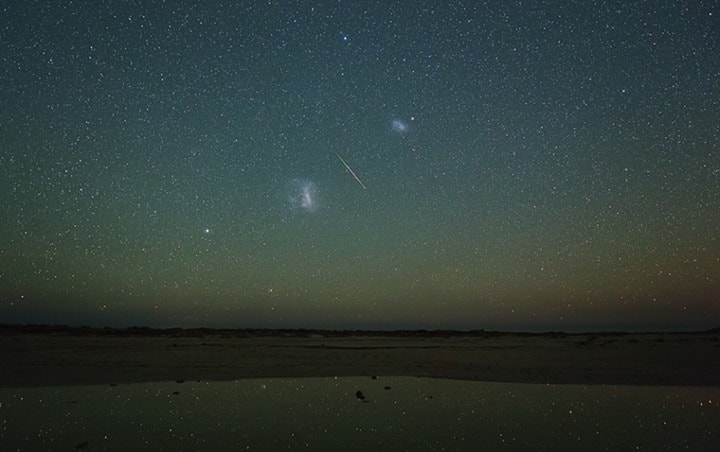
History
The magnificent Magellanic Clouds were always known by indigenous people living in the southern hemisphere. They are first recorded by Greek, Persian and Arabic astronomers as early as the 10th century. The Clouds became known in Europe in the 16th century on accounts of the reports made by Antonio Pigafetta, the Italian scholar who accompanied Ferdinand Magellan during his expedition in 1519–1522.
The first notion of the clouds being separate galaxies distinct from the Milky Way first appeared in the report from 1847 based on observations from Cape Observatory in South Africa. This report provided a detailed description and classification of hundreds of stars and nebulae visible in the Clouds. They were considered our closest satellite galaxies until 1995 when the Sagittarius Dwarf Elliptical Galaxy was discovered.
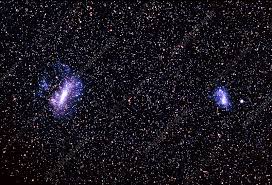
Formation
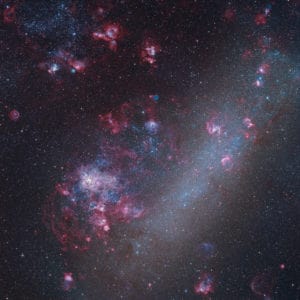
Contrary to the previous assumption, we discovered evidence that the Magellanic Clouds have not always orbited the Milky Way at the distance they are orbiting now. As a matter of fact, we now believe that the current distance between the three galaxies is a rare and unusual phenomenon for this system. This is partly due to clouds’ strange structure that doesn’t resemble other spherical or spiral galaxies that orbit the Milky Way.
The current hypothesis states that the two galactic clouds were once distant galaxies whose shape and structure got distorted by the gravitational influence of our galaxy, which is approximately ten times larger than they are. We believe that the LMC was once a spiral galaxy similar to the Triangulum galaxy, the third-largest in the Local Group.
Furthermore, we believe that the complex dance of the three galaxies may have resulted in the violent distortion of their internal structure which we see today. Both LMC and SMC seem to have structures similar to other barred spiral galaxies, a type of spiral structure with long central bars across the galaxy’s width and spiral arms stretching from its ends. We believe that tidal forces disrupted the spiral structure of the two galaxies, as well as the layer of gas and dust at the edge of the Milky Way, which was also distorted by the gravitational influence of our companion satellite galaxies. This gravitational pull can lead to the creation of new stars known as starburst when the gas and dust in the outer layers compress and collapse due to gravitational disruption as the galaxies get closer.
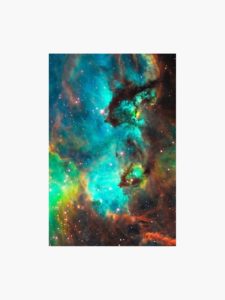
There are no many studies regarding the future of this cosmic pas de trois. A team of scientists from the Harvard-Smithsonian Center for Astrophysics and the Space Telescope Science Institute measured three-dimensional velocities of the two galaxies over the course of several years and found it to be almost twice as fast as previously thought. These precise and accurate measurements revealed that the LMC moves through space at 378 km/sec (235 miles/sec) and the SMC moves at the speed of 302 km/sec (188 miles/sec). This implies that either the mass of the Milky Way is much greater than previously calculated, or that the three galaxies are not gravitationally bound to each other and the current proximity and interaction are temporary, at least in a cosmic scale. This further implies that the Magellanic Clouds would most likely “fly away” from the Milky Way, only temporarily holding the status of its satellite galaxies.
Characteristics
The Magellanic Clouds have always captured observers’ attention because of their brilliant appearance in the night sky. The brightness of the two galaxies is due to an astonishing number of stars they hold. Unlike other satellite galaxies orbiting the Milky Way which contain up to 10 million stars, it was estimated that the Small Magellanic Cloud contains around 3 billion, while the Large Cloud harbour up to staggering 30 billion stars.
The two Magellanic Clouds are also considered strange because of the abundance of gas they contain. Satellite galaxies usually lose a substantial portion of the gas to the larger galaxies they orbit. This loss of material necessary for the creation of new stars results in a much higher number of old red stars within a galaxy. But the two clouds contain a lot of gas and have a much greater ratio of hydrogen and helium compared to our galaxy, which means that the larger fraction of their mass is constituted of these gases. This indicates that the two galaxies have much lower metallicity than the Milky Way.
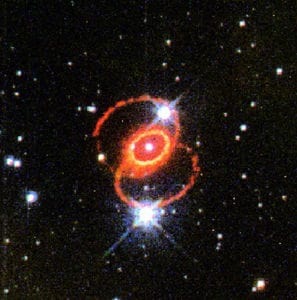
In astronomy, all elements heavier than helium and hydrogen are considered metals, and metallicity is a term used to describe the concentration of elements such as carbon, nitrogen, oxygen, and neon in nebulae and galaxies and is used to determine their masses. Observations of the Large Magellanic Cloud conducted using radio-telescopes revealed a clear spiral structure comprised of neutral hydrogen. The masses of the Magellanic Cloud Galaxies are hard to determine, but it was estimated that the LMC is probably the fourth most massive galaxy in the Local Group.
Both red and blue stars are found in the Clouds, as well as stunning nebulae and regions of high concentration of stellar formation. We found young blue stars within the Small Magellanic Cloud that are only a few hundred million years old. The Large Magellanic Cloud harbour one of the most luminous non-stellar object – the Tarantula Nebula, one of the most intense starburst regions in the galaxy. It is a remnant of a spectacular explosion whose light travelled 160 000 years to reach us, revealing yet another strangeness in the Universe. In 1987, a supernova dubbed SN 1987A was observed and it was the first supernova in the modern history that was studied in great detail. It was detected by the Las Campanas Observatory in Chile and revealed gamma-ray line radiation that persists in supernovae long after the implosion.
Probably the most crucial discovery resulting from this violent explosion was the fact that a type of stars known as blue supergiant can also cause a supernova event, which was contrary to the predictions of the stellar evolution models at that time. Other observations suggested that the supernova might have been a result of a collision of the blue supergiant with a companion star in a binary system.
Another weird thing about this spectacular explosion is the lack of a neutron star in its centre. When a star’s core collapses in a supernova event, the outer layers are usually scattered across the surrounding space and a neutron star usually forms in the centre. We have been searching for this remnant since 1990 using the Hubble Space Telescope, but images showed no such star or any other. Several hypotheses suggested several scenarios – that the star is obscured by a cloud of thick gas and dust, that the remnant is actually a quark star, or that a stellar-mass black hole might have formed when part of the scattered material fell back onto the neutron star.
Observation of the Magellanic Clouds led to some groundbreaking discoveries in modern astronomy. There are still questions that have not been answered and the previous assumptions were often disputed. We are still uncertain about the future of this slow galactic dance that may or may not result in a collision. What is certain is that the trio will continue to interact throughout billions of years, causing massive starbursts and unusual structural formations, making the night sky ever awe-inspiring.
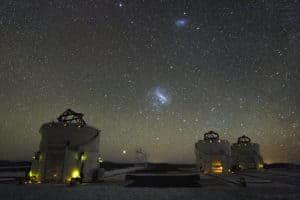
Bibliography
[1.] Mathewson, D. S.; Ford, V. L.; Visvanathan, N. (1986). “The structure of the Small Magellanic Cloud”. The Astrophysical Journal. 301: 664
https://ui.adsabs.harvard.edu/abs/1986ApJ...301..664M/abstract
[2.] Ferris, Timothy (December 2011). “Dancing in the Dark”. National Geographic. 220 (6): 118.
https://www.nationalgeographic.com/magazine/2011/12/magellanic-clouds/
[3.] Macri, L. M.; et al. (2006). “A New Cepheid Distance to the Maser-Host Galaxy NGC 4258 and Its Implications for the Hubble Constant”. The Astrophysical Journal. 652 (2): 1133–1149
https://arxiv.org/pdf/astro-ph/0608211v2.pdf
[4.] “A Cosmic Zoo in the Large Magellanic Cloud”. European Southern Observatory Press Release. European Southern Observatory: 21. 1 June 2010.
https://ui.adsabs.harvard.edu/abs/2010eso..pres...21./abstract
https://www.eso.org/public/news/eso1021/
[5.] Aguilar A. David (2007). “Press release: Magellanic Clouds May Be Just Passing Through”. The Harvard and Smithsonian Center for Astrophysics.
https://www.cfa.harvard.edu/news/2007-02
Image sources
[1.] https://en.es-static.us/upl/2013/08/meteor-Perseid-Magellanic-Clouds-Colin-Legg-8-11-2013.jpg
[2.] http://cdn.spacetelescope.org/archives/images/screen/opo9719b.jpg
[3.] https://live.staticflickr.com/4564/38559917201_082062295f_b.jpg
[4.] https://ih1.redbubble.net/image.200501316.1960/pp,650x642-pad,750x1000,f8f8f8.u4.jpg
[5.] https://encrypted-tbn0.gstatic.com/images?q=tbn:ANd9GcSD9bfrPF094ci_JBdSAdOFBGabaXauwe2P_i2Y-HtaAke-JCwU-w&s
[6.] http://www.miguelclaro.com/wp/wp-content/uploads/2016/01/VLTSmalls_6030-net.jpg
